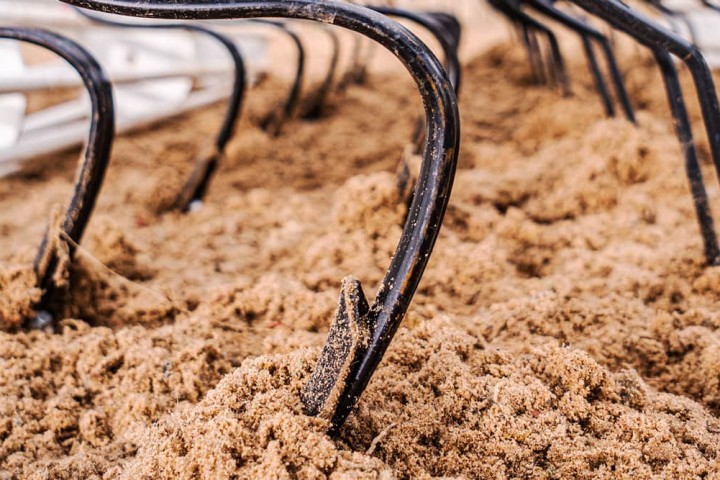Struggling with your riding surface maintenance? Here at Equestrian Surfaces, we’re regularly asked how you can keep your riding surfaces in tip-top condition throughout the year.
With spring well underway and many equestrians returning to outdoor training and riding, it’s the perfect time to ensure your surface performs at its best.
However, even the most experienced equestrians can make mistakes when it comes to maintaining their riding surfaces.
As a result, we’ve put together the most common riding surface maintenance mistakes we see among equestrians – so that you know how to avoid them…
Neglecting to remove debris and organic matter from the surface
Firstly, if you’ve not used your surface much throughout the winter months, it’s probable that leaves, sticks and other debris have accumulated over time.
It’s essential to remove this material in order to maintain a safe and consistent riding surface. You may also find flower petals, seeds, and newly grown foliage blowing onto your outdoor riding surface in the spring.
The consequences of neglecting to remove debris and organic matter from your surface are expensive and potentially dangerous. Foliage will contaminate both waxed and non-waxed surfaces, interfere with drainage systems, and reduce the overall longevity of your surface.
The solution: There are three main methods for removing foliage from your surface:
- Manually
- Leaf blowers
- Netting / Mesh
Not levelling the surface
Next on our list is failing to groom and level the surface thoroughly. Over the colder winter months, the freeze-thaw cycle can cause your surface to become uneven and harden. This can cause a horse to trip, stumble or lose their footing – increasing the risk of injury for both horse and rider.
The solution: Using a grader to drag and redistribute the surface material ensures consistency in the footing. This not only increases the safety of your surface, but it allows horses to develop muscle memory and perform movements with greater precision.
How often should you be grading your surface?
Regardless of the specific surface that you have, regular maintenance schedules are a necessity. By operating a daily maintenance programme during the spring months, you’ll become familiar with your surface and how it is affected by different weather conditions.
What tools should you use for grading your surface?
Here at Equestrian Surfaces Ltd, we manufacture and supply a range of high-quality Trackmaster graders for use on equestrian arenas and gallops. Each of our graders can be tailor-made to suit your bespoke requirements – and helps keep your surface level, groomed and stable.
Bonus tips for achieving a consistent rider surface:
Measure the depth of your surface – It’s also a good idea to regularly measure the depth of your surface at various points around your arena. This will allow you to identify any areas lacking in depth that may pose an increased risk of injury to your horse.
Switching training routes up – We also advise frequently rearranging jumps and obstacles in your arena, so that you can ensure each part of your surface is used evenly.
Overwatering or underwatering the riding surface
Let’s be honest; the weather is anything but predictable during the spring. One day we’re basking in the sunshine, and the next, we’re faced with treacherous downpours. As a result, another common problem we witness is clients either over or under-irrigating their surfaces.
What is surface irrigation? Surface irrigation is the process of applying water to your equestrian surface to rejuvenate a dry, hardened surface. This is needed frequently on unwaxed surfaces, where the material is prone to drying out and becoming uneven.
A common telltale sign that your surface requires irrigation is if the sand has separated from the fibre, and the sand has formed a hard, dry, compact layer beneath.
However, whilst underwatering your surfaces creates a dry and hard surface that increases the risk of injury – overwatering is detrimental, too. An overwatered surface can lead to soft patches which occur with excessive moisture retention which is unsuitable for horse and rider.
The solution: Believe it or not, there is a middle ground. Follow these four steps to ensure your surface maintains the most effective degree of irrigation.
Step 1 – Assess your surface type – Waxed and non-waxed surfaces have different irrigation requirements. One of the many perks of waxed surfaces is that they require less irrigation than non-waxed surfaces, as they generally retain more moisture.
Step 2 – Test the surface – To determine whether your surface needs watering, walk on it and feel the consistency of the footing. If it feels dry and hard, irrigation is needed. If it feels wet and slippery, you don’t need to irrigate yet.
Step 3 – Use a suitable irrigation system – There are a number of irrigation systems available, do your research to ensure you’ve got the most suitable one for your needs. Ensure even distribution of water across the surface.
Step 4 – Monitor the results – Regularly inspect your surface to ensure it remains consistent and safe for riding on. Spring in the UK can throw several curveballs when it comes to the weather. Some weeks are much wetter than others, so remember to check your surface and adjust your irrigation schedule accordingly.
What are the consequences of failing to sufficiently manage your riding surface maintenance?
- Reduced surface lifespan, leading to higher expenses
- Greater risk of injury for horses and riders
- Higher chances of weeds and unwanted growth
- Loss of professionalism, which is crucial for events and competitions
Need a hand with your riding surface maintenance this spring?
You’re in the right place. Here at Equestrian Surfaces Ltd, we have a range of quality maintenance solutions to give your surface some well-deserved TLC.
For bespoke advice and solutions, give our team of experts a ring on 01282 834 970.























